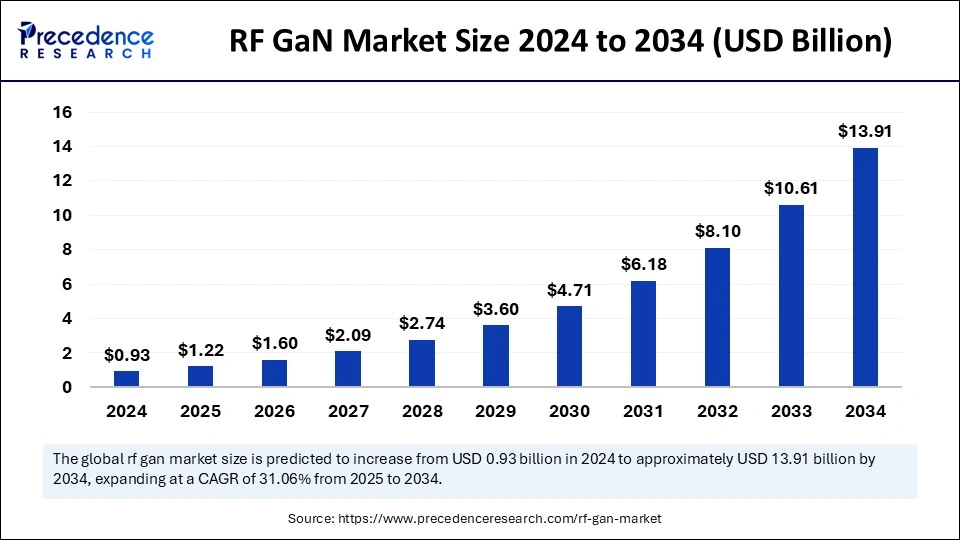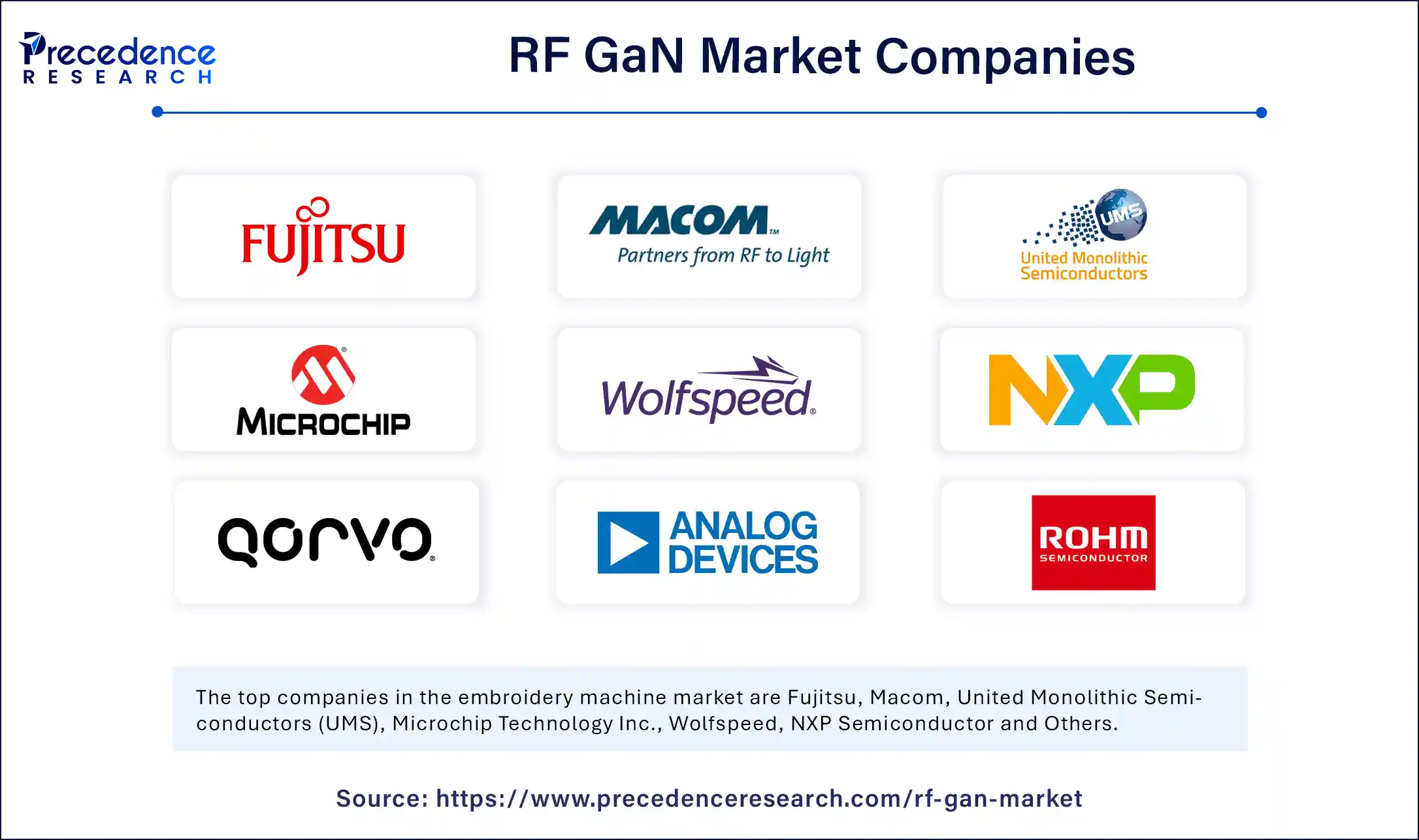The global RF GaN market size surpassed USD 0.93 billion in 2024 and is projected to reach around USD 13.91 billion by 2034 with a CAGR of 31.06% from 2025 to 2034.

Get a Free Sample Copy of the Report@ https://www.precedenceresearch.com/sample/5799
RF GaN Market Key Highlights
-
In 2024, Asia Pacific held the top spot in the RF GaN market, accounting for 43% of the total share.
-
North America is forecasted to expand steadily with a strong CAGR in the coming years.
-
GaN-on-Si emerged as the leading material segment.
-
GaN-on-SiC is gaining traction and is expected to grow rapidly.
-
Military applications drove the highest demand in 2024.
-
The RF energy sector is anticipated to witness rapid expansion moving forward.
RF GaN Market Key Highlights
Artificial Intelligence is playing an increasingly pivotal role in shaping the RF GaN market by enabling smarter design, manufacturing, and deployment of RF components. One of the most significant applications of AI lies in design optimization. Using advanced simulation tools and machine learning algorithms, engineers can analyze large datasets to create more compact and efficient RF GaN circuits. This helps improve performance attributes such as power density, linearity, and thermal management while shortening development timelines.
In manufacturing, AI supports predictive maintenance and quality control. AI-enabled systems monitor production lines in real time and detect anomalies or inefficiencies that might affect product quality. These systems can predict potential equipment failures or deviations, helping manufacturers reduce downtime, improve yield, and maintain consistent quality standards. AI also assists in analyzing the physical and chemical properties of GaN materials, aiding in the discovery and testing of new material compositions that offer enhanced reliability and efficiency.
AI’s impact is also felt in the deployment of RF GaN technologies, especially within telecommunications and defense sectors. For telecom applications such as 5G and beyond, AI helps optimize network configurations, manage beamforming, and ensure signal integrity, which are critical for high-frequency RF GaN devices. In defense, AI enhances radar and electronic warfare capabilities by enabling smarter signal processing, target recognition, and decision-making under dynamic conditions.
What is RF GaN?
RF GaN (Radio Frequency Gallium Nitride) is a specialized semiconductor material that is increasingly used in high-frequency applications, particularly in telecommunications, radar systems, and other wireless communication technologies. Gallium Nitride (GaN) is a wide-bandgap semiconductor, which means it can operate at higher voltages, frequencies, and temperatures compared to traditional semiconductor materials like silicon. These properties make GaN especially suitable for RF (radio frequency) applications, where efficiency, power, and thermal performance are critical.
Key Characteristics of RF GaN:
-
High Power Density: RF GaN offers superior power output compared to conventional materials, making it ideal for high-power applications like base stations, radars, and satellite communications.
-
Efficiency: RF GaN devices exhibit higher efficiency at high frequencies, leading to lower energy consumption and less heat generation. This translates into improved performance and longer operational life for electronic systems.
-
Thermal Stability: GaN devices can operate at much higher temperatures without losing performance, making them suitable for demanding environments where heat dissipation is crucial.
-
Compact Design: Due to its high power density, RF GaN allows for more compact and lightweight components without sacrificing performance, which is especially valuable for aerospace, defense, and telecom sectors.
-
High Frequency and Speed: RF GaN supports higher frequency operations, which is necessary for modern communication systems like 5G and beyond, where high-speed data transmission is required.
Applications of RF GaN:
-
Telecommunications: RF GaN is heavily used in base stations, mobile communications (including 5G), and satellite communication systems due to its ability to provide high power, efficiency, and speed at high frequencies.
-
Military and Defense: RF GaN is vital for radar systems, electronic warfare, and communication systems, providing high-frequency capabilities and robustness in harsh environments. Its ability to work at high powers and frequencies makes it an essential technology for military applications.
-
Automotive: RF GaN is used in automotive radar systems for advanced driver assistance systems (ADAS) and autonomous vehicle technologies, where high-frequency, accurate, and reliable performance is essential.
-
Industrial: RF GaN is also used in industrial applications like RF energy systems for heating, curing, and drying processes.
Growth Factors:
The growing demand for higher-frequency communication systems, including 5G and satellite communications, is driving the adoption of RF GaN technology. Additionally, advancements in defense systems and the increasing need for power-efficient, compact electronic devices contribute to the market’s growth.
Challenges:
Despite its numerous advantages, RF GaN technology faces challenges such as high manufacturing costs and complexity. The development of efficient, cost-effective fabrication processes is crucial for expanding its adoption in more applications.
Market Outlook:
The RF GaN market is expected to experience significant growth, driven by increasing demand for high-frequency power systems, particularly in telecom, defense, and aerospace industries. As technology advances and production processes improve, the cost of RF GaN devices is expected to decrease, making them more accessible to a wider range of applications and industries.
Market Scope
| Report Coverage | Details |
| Market Size by 2034 | USD 13.91 Billion |
| Market Size in 2025 | USD 1.22 Billion |
| Market Size in 2024 | USD 0.93 Billion |
| Market Growth Rate from 2025 to 2034 | CAGR of 31.06% |
| Dominated Region | Asia Pacific |
| Fastest Growing Market | North America |
| Base Year | 2024 |
| Forecast Period | 2025 to 2034 |
| Segments Covered | Material Type, Application, and Regions |
| Regions Covered | North America, Europe, Asia-Pacific, Latin America and Middle East & Africa |
Market Dynamics
Market Drivers
Several factors are driving the growth of the RF GaN market. The expansion of 5G networks globally has significantly increased the demand for GaN-based RF components due to their capability to handle higher frequencies and power levels. In the defense sector, GaN technology is increasingly used in radar and electronic warfare systems because of its enhanced performance in high-stress environments. Additionally, the growing preference for GaN in satellite communication systems and base station amplifiers due to its efficiency and compact size is further accelerating market adoption. The shift from silicon to GaN is largely being driven by the growing need for miniaturized and high-efficiency RF solutions.
Opportunities
The RF GaN market presents several promising opportunities, especially in the areas of emerging wireless technologies, such as 6G, aerospace advancements, and industrial RF energy applications. There is a rising demand for GaN in autonomous vehicle radar systems and next-generation military radar platforms. Moreover, ongoing research and development focused on improving GaN fabrication and packaging technologies could significantly reduce costs and expand its adoption across cost-sensitive industries. The increased use of GaN in space applications, particularly for satellite payloads and communication systems, also opens up new revenue streams for manufacturers.
Challenges
Despite its potential, the RF GaN market faces some notable challenges. High production costs remain a significant barrier, primarily due to expensive substrates like silicon carbide (SiC) and the complex manufacturing processes involved. Limited availability of GaN wafers and the need for advanced design expertise also pose difficulties for smaller companies trying to enter the market. Additionally, standardization and reliability testing protocols for RF GaN components still require further development to gain broader acceptance in highly regulated industries like aerospace and defense. These factors may slow down the mass adoption of RF GaN technologies.
Regional Insights
Asia Pacific led the global RF GaN market in 2024, capturing the largest market share due to the presence of major electronics manufacturers and growing investments in 5G infrastructure, defense modernization, and industrial automation in countries like China, South Korea, and Japan. North America is expected to witness strong growth over the forecast period, driven by its advanced defense programs, robust aerospace industry, and increasing deployment of 5G networks. Europe is also emerging as a significant market, particularly in defense and automotive radar applications. Continued regional investments in communication technologies and semiconductor research are expected to fuel further expansion of the RF GaN market worldwide.
RF GaN Market Companies

- Fujitsu
- Macom
- United Monolithic Semiconductors (UMS)
- Microchip Technology Inc.
- Wolfspeed
- NXP Semiconductor
- Qorvo, Inc.
- Analog Devices Inc.
- ROHM Semiconductors
- STMicroelectronics NV
- Infenion technologies
Recent Developments
- In January 2025, Guerrilla RF, Inc. introduced the GRF0020D and GRF0030D as the initial members of their new GaN on SiC HEMT power amplifier product series. The GaN HEMT transistors offer 50W of saturated power to clients in wireless infrastructure, military, aerospace as well and industrial heating applications that need integrated bare die for their custom MMICs.
- In June 2024, Tagore Technology introduced the TS8729N and TS8728N series of high-power GaN SPDT switches for broadband applications. The switches deliver superior power handling in addition to outstanding insertion loss to serve L- and S-Band radar and cellular infrastructure.
Segments Covered in the Report
By Material Type
- GaN-on-Si
- GaN-on-SiC
- Other Material Types (GaN-on-GaN, GaN-on-Diamond)
By Application
- Military
- Telecom Infrastructure (Backhaul, RRH, Massive MIMO, Small Cells)
- Satellite Communication
- Wired Broadband
- Commercial Radar and Avionics
- RF Energy
By Geography
- North America
- Asia Pacific
- Europe
- Latin America
- Middle East and Africa
Also Read: Construction and Design Software Market
Ready for more? Dive into the full experience on our website@ https://www.precedenceresearch.com/
